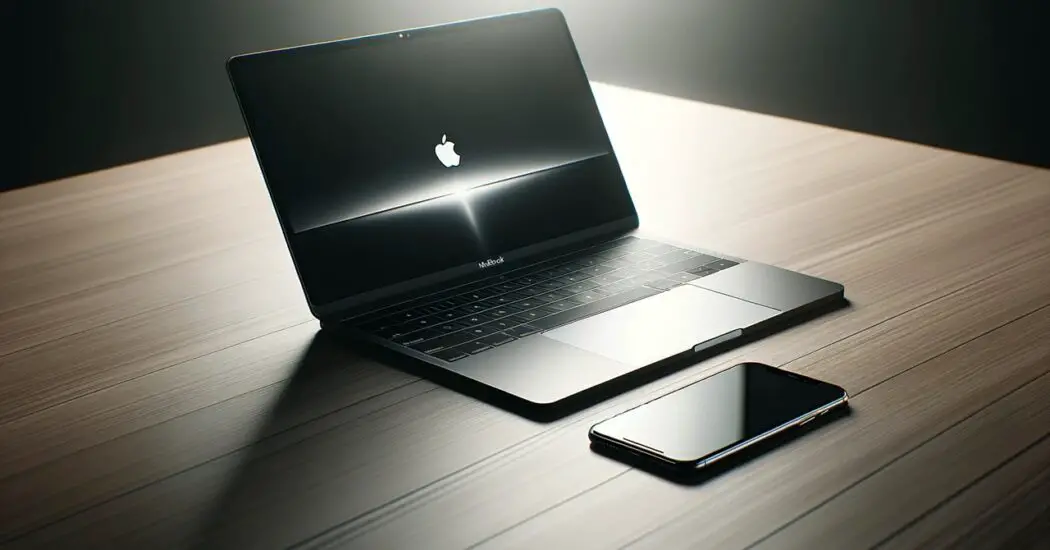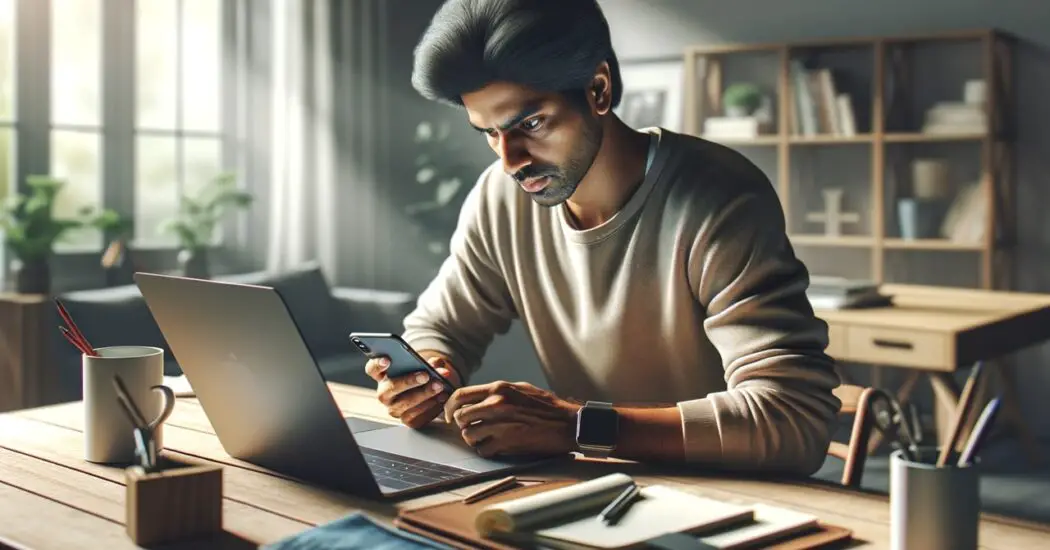Knowing how to use an iPhone camera as a webcam for MacBook is great If you’re looking to enhance your video conferencing experience. This technique allows you to leverage the superior camera quality of your iPhone for your virtual meetings, streaming, or any other webcam needs. In this guide, we will walk you through the entire process step-by-step.

Table of Contents
How to Use an iPhone Camera as a Webcam for MacBook Step by Step
Follow the steps below to use an iPhone camera as a webcam for MacBook…
Step 1: Gather the Necessary Tools
Before embarking on this journey to enhance your video call experience, it’s essential to have all the tools at hand. Firstly, you’ll need two primary devices: your iPhone and your MacBook. Your iPhone will serve as your new, high-quality webcam, while your MacBook will be the platform where this transformation takes place.
A stable and reliable internet connection is paramount in this process. A poor connection can disrupt the syncing between your devices, leading to a subpar experience. Therefore, ensure your Wi-Fi network is strong and stable or consider a direct connection via USB as a fail-safe alternative.
The magic that links your iPhone’s camera to your MacBook is specialized software designed to bridge this connection. A popular and user-friendly choice is ‘EpocCam.’ This app is readily available on the Apple App Store and is revered for its ease of use and reliability.
It will serve as the conduit for transmitting your iPhone’s camera feed to your MacBook. Before proceeding to the next step, download the EpocCam app from the App Store onto your iPhone.
Step 2: Install the Required Software
Now that you have your tools ready, it’s time to set the stage for them to work together. Begin by installing the EpocCam app on your iPhone. This process is as simple as downloading any app from the App Store. Search for ‘EpocCam‘ in the App Store, download, and install it on your iPhone.
However, installing the app on your iPhone is only half the task. For your MacBook to recognize and utilize your iPhone’s camera, it needs to speak the same language as your iPhone. This is where the EpocCam drivers come into play. These drivers act as a translator, enabling seamless communication between your MacBook and iPhone.
To install these drivers, visit the developer’s website on your MacBook. Look for the section dedicated to downloads or drivers, and select the version compatible with your MacBook. Follow the installation instructions carefully. This step is crucial because without these drivers, your MacBook won’t recognize the video feed from your iPhone, rendering the effort futile.
Once both the app and the drivers are installed, you’ve laid the foundation for a successful integration of your iPhone’s camera with your MacBook. This setup will ensure that your devices can communicate with each other effectively, paving the way for a superior video conferencing experience.
Step 3: Connect Your iPhone to Your MacBook
With the necessary software now installed on both your iPhone and MacBook, it’s time to create a bridge between these two devices. Start by opening the EpocCam app on your iPhone. This app will transform your iPhone into a high-quality webcam, but first, it needs to connect to your MacBook.
For this connection, you have two options: Wi-Fi or USB. If you choose Wi-Fi, ensure that both your iPhone and MacBook are connected to the same Wi-Fi network. This similarity in connection is vital for ensuring they can communicate with each other.
When using a Wi-Fi connection, it’s also important to keep both devices within a reasonable distance to maintain a strong and stable connection. Weak or unstable connections can lead to poor video quality or connection drops, which can be frustrating during important video calls.
Alternatively, if you prefer a more stable and reliable connection, you can use a USB cable. Simply connect your iPhone directly to your MacBook using the cable. This method often provides a more consistent and lag-free experience, as it doesn’t rely on the stability of a Wi-Fi network.
Read more iPhone camera topics here – iPhone Camera: How To, Problems & Solutions
Step 4: Configure the Settings
Once your iPhone is connected to your MacBook via Wi-Fi or USB, it’s time to integrate this setup into your video conferencing environment. Turn your attention to your MacBook and open the video conferencing application you plan to use. This could be Zoom, Skype, Microsoft Teams, or any other platform that you regularly use for video calls.
In your chosen application, navigate to the settings or preferences section. This is typically found in the menu bar or within the application’s options. Within these settings, look for the video or camera options. Here, you will be presented with a list of available video sources.
From this list, select ‘EpocCam’ as your video source. This action tells the application to use your iPhone’s camera, now connected and ready via EpocCam, as the webcam for your calls.
Once selected, you should immediately see the video feed from your iPhone’s camera displayed on your MacBook. This feed is what will be transmitted to your call participants, showcasing the improved video quality offered by your iPhone’s camera.
Take a moment to adjust the position of your iPhone or the room’s lighting if necessary. This ensures the best possible video quality. With these settings configured, you’re now ready to enjoy higher-quality video calls using your iPhone’s camera, all thanks to the seamless integration facilitated by EpocCam.
Step 5: Secure Your iPhone
Now that your iPhone is connected and set as the webcam, it’s crucial to position it correctly. Start by finding a stable and secure spot for your iPhone. You might use a dedicated smartphone stand or holder. These are designed to grip your phone tightly and can often be adjusted to different angles, making them ideal for this purpose.
If you don’t have a stand, you can improvise with everyday items to prop up your iPhone, but ensure it’s stable and won’t easily tip over during your call.
Once your iPhone is in its holder or propped up securely, focus on the camera lens. A clean lens is essential for clear video quality. Gently wipe the lens with a soft, lint-free cloth to remove fingerprints or dust. Even the smallest smudge can blur your video, so this step is more important than it might seem.
Next, adjust the angle of your iPhone. The goal is to frame your face in a way that looks natural and engaging on camera. Generally, it’s best to have the camera at eye level.
This angle is most flattering and simulates a face-to-face conversation. Experiment with the positioning to find the best angle that captures your face and upper torso, ensuring a professional appearance for your video calls.
Step 6: Test Your Setup
Before you jump into any important meetings or calls, it’s a good idea to test your new webcam setup. This step ensures that everything is working as it should be and that you’re presenting yourself in the best light.
Start by recording a short video on your MacBook. Ensure that the iPhone camera is selected as the video source. You can do this through any application that allows video recording, or even within the video conferencing software you plan to use. Record yourself speaking and moving a bit to get a sense of both the audio and visual quality.
Once you’ve recorded the video, play it back. Look and listen for clarity in both the video and audio. Check to see if your face is well-lit and easily visible, without any harsh shadows or overexposure. Make sure there’s no lag, and the video quality is high, reflecting the superior capabilities of your iPhone’s camera.
If you notice any issues with the video or audio quality, take the time to make adjustments. This might mean repositioning your iPhone, changing your room’s lighting, or adjusting your seating position. It’s all about finding the sweet spot where everything looks and sounds as good as possible.
Troubleshooting Common Issues: How to Use an iPhone Camera as a Webcam for MacBook

Even with careful setup, you might encounter some issues while using your iPhone camera as a webcam for your MacBook. Let’s address these common problems and find effective solutions to keep your video calls running smoothly.
Connection Problems
A common issue is that your MacBook might not recognize your iPhone camera. The first thing to check is whether both devices are connected to the same Wi-Fi network. This step is crucial for a wireless connection. If they are on different networks, the devices won’t communicate properly.
If they are on the same network and you’re still facing issues, try restarting both your iPhone and MacBook. This simple action can often resolve connectivity problems. Turn off both devices, wait for a minute, and then turn them back on. After they reboot, try establishing the connection again.
If you’re using a USB connection instead of Wi-Fi, make sure the cable is securely plugged into both the iPhone and the MacBook. Also, check the USB port on your MacBook. Sometimes, a different port might work better if the one you’re using is not functioning correctly.
Video Quality Concerns
Experiencing poor video quality can be frustrating. First, assess the strength and stability of your internet connection. A weak or unstable connection can lead to poor video quality. If you’re on Wi-Fi, try moving closer to your router or using a wired connection for better stability.
Another factor that can affect video quality is the number of applications running on your devices. Close any unnecessary apps on both your iPhone and MacBook that could be consuming bandwidth. This frees up resources for your video call, potentially improving video quality.
Additionally, a dirty camera lens can significantly degrade video quality. Gently clean your iPhone’s camera lens with a soft, lint-free cloth to remove any smudges, dust, or fingerprints.
Software Issues
Sometimes the video conferencing application might not show your iPhone camera as an available video source. First, ensure that you have correctly installed all necessary drivers on your MacBook and that the EpocCam app is running on your iPhone.
If everything seems to be installed correctly, check for updates. Ensuring that your iPhone, MacBook, and all related software are up to date is crucial for compatibility and performance. Visit the App Store on your iPhone and the Mac App Store on your MacBook to check for any available updates for your devices and the EpocCam app.
Conclusion: How to Use an iPhone Camera as a Webcam for MacBook
Using your iPhone camera as a webcam for your MacBook can significantly upgrade the quality of your video calls. With the steps outlined above, you can set up your devices for a professional and clear video experience. Remember to test your setup before any important calls, and you’ll be prepared to make a great impression.